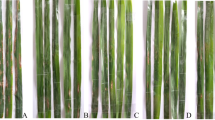Abstract
Four species of indigenous Japanese Agropyron, namely, Elymus humidus Osada (= Agropyron humidum), E. tsukushiensis Honda var. transiens (= A. tsukushiense), E. racemifer Tsvel. (= A. ciliare) and A. mayebaranum var. intermedium Hatusima were collected and evaluated for their resistance to Fusarium head blight (FHB, scab) after inoculation with a conidial suspension of Fusarium graminearum Schwabe at the flowering stage. The resistance to penetration of FHB and to fungal invasion of rachis internodes was evaluated in each accession in a comparison with six wheat cultivars. The results demonstrated that AG.91-35 of E. humidus and AG.91-24 of E. racemifer had higher resistance to penetration than the resistant wheat cultivars Nobeokabouzu-komugi and Sumai 3, respectively. All accessions of indigenous Japanese species of Agropyron examined, with the exception A. mayebaranum, had a statisticallysimilar resistance to invasion, which was the same as that of Nobeokabouzu-komugi or Sumai 3. In all accessions of E. humidus, with only one exception, no spread of the fungus from the infected spikelets to the rachis internodes was detected at all. The possible application of the strains of Agropyron as genetic resources for development of resistance to FHB in wheat is discussed.
Similar content being viewed by others
References
Ban, T., 1991. Efficiency of ‘cut-spike’ inoculation method for evaluation of scab resistance in wheat. Japan. J. Breed. 41(2): 404 (in Japanese).
Chhabra, A.K. & S.K. Sethi, 1991. Inheritance of cleistogamic flowering durum wheat (Triticum durum). Euphytica 55: 147-150.
Dewey, D.R., 1984. The genomic system of classification as a guide to intergeneric hybridization with the perennial Triticeae. In: J.P. Gustafson (Ed.), Gene Manipulation in Plant Improvement, pp. 209-279. Plenum Press, New York and London.
Gocho, H., 1985. Wheat breeding for scab resistance. Wheat Inf. Serv. 60: 41.
Kanatani, R. & K. Takeda, 1991. A method for mass sporulation in a scab disease pathogen (Fusarium graminearum Schwabe). Nogaku Kenkyu 62: 177-189 (in Japanese with English summary).
Kitani, K. & Y. Inoue, 1957. On the primary occurrence of the wheat scab and its developing process. Bull. Shikoku Agric. Exp. Stn. 3: 125-138.
Li, Y. & Y. Yu, 1990. A diallel analysis on resistance index to scab in seven wheat cultivars. In: Advances in Researches on Resistance to Diseases in Major Crops, pp. 185-192. Jiangsu Sci. & Tec., Jiangsu (in Chinese).
Miller, J.D., J.C. Young & D.R. Sampson, 1985. Deoxynivalenol and Fusarium head blight resistance in spring cereals. J. Phytophathology 113: 359-367.
Muramatsu, M., 1994. Triticeae and Bambuseae species distributed in Japan and their characteristics as genetic resources. Sci. Report Fac. Agric. Okayama Univ. 83: 65-90 (in Japanese with English summary).
Muramatsu, M., S. Kaneta, R. Ikeda, T. Uetsuki & K. Takahashi, 1983. Hybridization of Japanese indigenous Agropyron (Roegneria) species with hexaploid wheat and cytogenetics of some of the F1, BC1 and amphiploid plants. In: S. Sakamoto (Ed.), Proc. 6th Intl. Wheat Genet. Symp. (Kyoto, Japan), pp. 1041-1048. Maruzen Co., Ltd., Kyoto.
Naito, H., S. Mogi, H. Gocho & T. Hirai, 1984. A simple method for evaluation of varietal resistance to scab caused by Gibberella zeae Petch in wheat. Bull. Kyushu Natl. Agric. Exp. Stn. 23: 355-386 (in Japanese with English summary).
Osada, T., 1989. Illustrated Grasses of Japan. Heibonsya Ltd., Tokyo (in Japanese).
Parry, D.W., P. Jenkinson, J. Liggitt, A. Hilton & J.A. Clement, 1996. Significance and control of Fusarium ear blight (scab) in winter wheat. In: Fusarium Head Scab: Global Status and Future Prospects. (CIMMYT, Mexico) (in press).
Sakamoto, S. & M. Muramatsu, 1966. Cytogenetic studies in the tribe Triticeae. II. Tetraploid and hexaploid hybrids of Agropyron. Japan. J. Genetics 42: 155-168.
Schroeder, H.W. & J.J. Christensen, 1963. Factors affecting resistance of wheat to scab caused by Gibberella zeae. Phytopathology 53: 831-838.
Sethi, S.K. & A.K. Chhabra, 1990. Cleistogamy in wheat. RACHIS (ICARDA) 9: 34-36.
Sharma, H.C. & B.S. Gill, 1983. Current status of wide hybridization in wheat. Euphytica 32: 17-31.
Snijders, C.H.A., 1990a. Diallel analysis of resistance to head blight caused by Fusarium culmorum in winter wheat. Euphytica 50: 1-9.
Spjotvoll, E. & M.R. Stoline, 1973. T-method of multiple comparison to include the cases with unequal sample sizes. J. American Statistical Association 68: 976-978.
Takeda, K. & H. Heta, 1989. Establishing the testing method and search for the resistant varieties to Fusarium head blight in barley. Japan. J. Breed. 39: 203-216 (in Japanese with English summary).
Takata, K. & M. Muramatsu, 1992. Genetic studies on the Triticeae, Gramineae II. Production of disomic addition lines of Elymus ciliaris chromosomes. Japan. J. Breed. 42(Suppl. 2): 368-369 (in Japanese).
Van Ginkel, M., W. Van Der Schaar & Z. Yang, 1996. Inheritance of resistance to scab in two wheat cultivars from Brazil and China. Plant Disease 80: 863-867.
Weng, Y. & D. Liu, 1989. Morphology, scab resistance and cytogenetics of intergeneric hybrids of Triticum aestivum L. with Roegneria c. Koch (Agropyron) species. Scientia Agric. Sinica 22: 1-7 (in Chinese with English summary).
Weng, Y.Q., L.F. Wu., P.D. Chen & D.J. Liu, 1993. Development of alien addition lines of wheat scab resistance from Roegneria kamoji C. Koch. In: Z.S. Li & Z.Y. Xin (Eds.), Proc. 8th Intl. Wheat Genet. Symp. (Beijing, China), pp. 365-368. China Agric. Sci. Press, Beijing.
Author information
Authors and Affiliations
Rights and permissions
About this article
Cite this article
Ban, T. Evaluation of resistance to Fusarium head blight in indigenous Japanese species of Agropyron (Elymus). Euphytica 97, 39–44 (1997). https://doi.org/10.1023/A:1003078109694
Issue Date:
DOI: https://doi.org/10.1023/A:1003078109694




